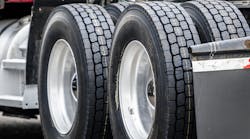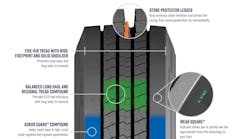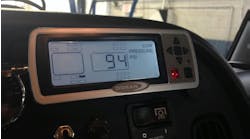A commercial vehicle reaches maximum efficiency when everything on the vehicle is operating as it was designed to run. Attaining this is unlikely because there are so many factors that affect operation, but more efficient trucks cost less to operate, so the pursuit of perfection never ends.
Since the rolling resistance of tires represents up to 30% of a vehicle’s fuel consumption and emissions, the rubber on the road tends to get a lot of attention. The rise in popularity of low rolling resistance (LRR) tires and retreads links directly to the fuel-island savings for some carriers, while other haulers have different operational requirements that are met by tread designs and compounds that don’t feature LRR performance.
But LRR tires and retreads won’t move the needle as designed when tires and wheel assemblies are not properly matched. At a minimum, the sizes must be identical across the axle, the exception being 295/75R22.5 and the 275/80R22.5 tires, which have the same basic diameter. When it comes to sizing, it’s also important to recognize that tire dimensions are nominal, meaning there are small differences.
See also: Calculating the TCO of LRR tires
For example, a quick check of popular low-profile 22.5-inch tires in a SmartWay LRR trailer application revealed outside diameters ranged from 39.5 to 40.1 in. A difference of half an inch doesn’t seem like much, but the maximum allowable difference in diameter between dual tires is exactly that, so new tires with the same size from different manufacturers could be at or slightly over the dual matching tolerances.
The new tread depths also ranged from 11/32 to 13/32 in the same size and SmartWay LRR category. In fact, there were several instances where mismatched tread depth produced a perfect match in diameter. When tires with the same size and a 2/32 difference in new tread depth have the exact same diameter, the dimensions are nominal.
The best way to achieve perfectly matched duals is to make sure the tires are from the same manufacturer and the same size and tread design. Retreads, however, can be the exact same outside diameter with different casings because modern computer buffers create identical diameters, regardless of the manufacturer. It’s still important to note that new retreads can be the same size with different diameters. There are no guarantees with sizing and physical dimensions when it comes to matching dual tires if they are not identical in every way.
When dual tires are mismatched, all the technology that goes into compounding, tread design, and casing construction becomes less effective. A larger tire carries more load, so the possibility of an overload increases. A smaller tire can’t keep up with the difference in revolutions per mile, so irregular wear is certain as a smaller tire skids and drags a little bit every day. If tires are the same size, manufacturer, and tread design, matching is as easy as making sure the tread depth is within 4/32 for both tires in the dual. If these features are not the same, the extra step of physically measuring the diameter or circumference is necessary to achieve optimal matching.
See also: Tires in real time: Managing psi and tread depth
Diameter isn’t the only area where mismatches occur. Tire pressure must be uniform in dual positions and across the axle. Uneven pressure in a dual application can cause irregular wear as well as casing fatigue. Like mismatched duals, any benefits of low rolling resistance are negated by the differences in the footprint of underinflated tires. The larger footprint of an underinflated tire increases rolling resistance and adds heat in the tire and wheel end assembly.
Even though over-inflation has the opposite effect by improving low rolling resistance with a smaller footprint, accelerated wear and increased risk of impact damage results in higher tire costs, which negates any fuel economy gains. A smaller footprint also may degrade handling, since there is less rubber in contact with the road.
For all the tires on a commercial vehicle to perform as designed, everything must be matched. The rims must have the correct width for the tire. Any differences in diameter for dual tires must be within a half inch. Tire pressure must be identical in dual positions, across the axle and between tandem axles on tractors and trailers. The consequences of mismatches can vary, but they typically result in higher tire and fuel costs.
Kevin Rohlwing is the SVP of training for the Tire Industry Association. He has more than 39 years of experience in the tire industry and has created programs to help train more than 180,000 technicians.



